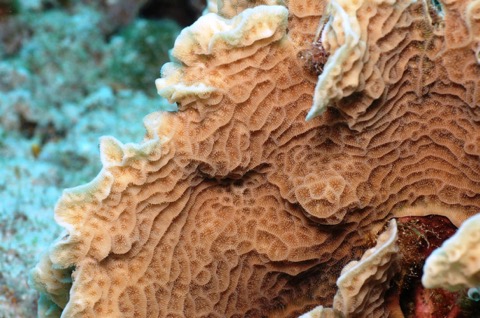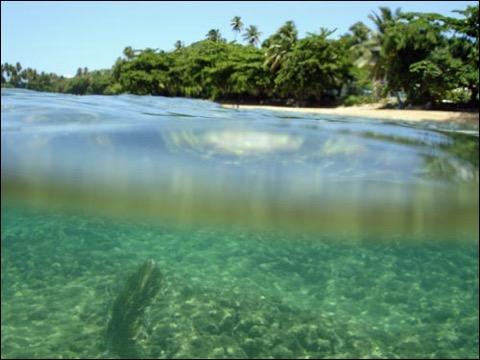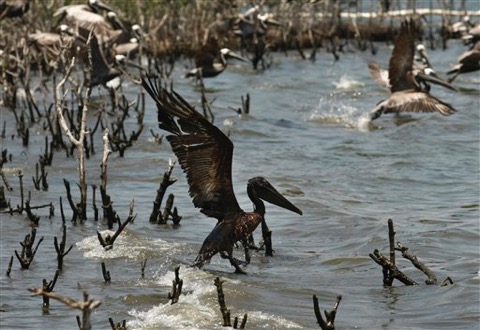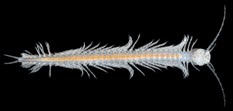corals
More Shouts
19/10/12 09:39
It’s been a good week for the Wares Lab. Christine Ewers passed her oral examinations on Tuesday and is now a Ph.D. candidate; her fortune came through wildly the next day when she found out that - having entered one of the numerous drawings that they hold at product shows - she won an $8000ish ABI thermal cycler! We haven’t figured out the details on this prize yet but obviously a pretty exciting win.

Also, doctoral student Meredith Meyers just (probably) landed her second publication in the last two months as she just got word from Journal of Heredity that only very minor revisions are necessary for her paper on fluorescent protein sequence evolution in the coral genus Agaricia. This is exciting not just because it is a publication, but this was the most technically punishing paper that she and I have had to work on and it touches on the boundaries of what we know as molecular evolution folk. When there are multiple copies of a gene in a group of organisms (and I suppose it is also possible that those species are hybridizing!), that means that the variation that is present in what we can survey represents allelic variation at a locus, the divergence of gene copies, and the divergence of gene copies in different species. Unfortunately, it is very difficult to tell where to draw the lines between these different ‘containers’ of diversity, but Meredith did a very good job examining the problem and I’ll post publication details when they are available.
Finally, long-time Wares Lab associate Jamie Winternitz (Altizer Lab, Odum School of Ecology) defends her dissertation today. Fantastic, difficult work on the interaction of immune system evolution and parasite load in montane voles. Looking forward to hoisting a beer in her honor later today.
You should be nervous for us. Please note the number of chickens I’ve counted before they’ve hatched in this post!

Also, doctoral student Meredith Meyers just (probably) landed her second publication in the last two months as she just got word from Journal of Heredity that only very minor revisions are necessary for her paper on fluorescent protein sequence evolution in the coral genus Agaricia. This is exciting not just because it is a publication, but this was the most technically punishing paper that she and I have had to work on and it touches on the boundaries of what we know as molecular evolution folk. When there are multiple copies of a gene in a group of organisms (and I suppose it is also possible that those species are hybridizing!), that means that the variation that is present in what we can survey represents allelic variation at a locus, the divergence of gene copies, and the divergence of gene copies in different species. Unfortunately, it is very difficult to tell where to draw the lines between these different ‘containers’ of diversity, but Meredith did a very good job examining the problem and I’ll post publication details when they are available.
Finally, long-time Wares Lab associate Jamie Winternitz (Altizer Lab, Odum School of Ecology) defends her dissertation today. Fantastic, difficult work on the interaction of immune system evolution and parasite load in montane voles. Looking forward to hoisting a beer in her honor later today.
You should be nervous for us. Please note the number of chickens I’ve counted before they’ve hatched in this post!
Marine Biology
13/10/10 15:15
How funny is it to call yourself a marine biologist?
McSweeney’s knows it is funny.
Seinfeld knew it was funny.
And with colleagues like J-Long, it IS funny.
After the hairy theory/numerical/simulation Genetics paper our lab group read today though, I’d rather call myself a marine biologist any day!
McSweeney’s knows it is funny.
Seinfeld knew it was funny.
And with colleagues like J-Long, it IS funny.
After the hairy theory/numerical/simulation Genetics paper our lab group read today though, I’d rather call myself a marine biologist any day!
Up-and-comers
13/09/10 09:24

The image above is from Iliana Baums’ lab - one of several working on the imperiled elkhorn coral, Acropora palmata (and really, most of the rest of us are following the lead of Iliana and her students!). This picture was taken in Puerto Rico, and I snagged it from the web to commemorate another addition to the fleet of researchers working on these corals. SUNFIG student Jesyka Meléndez, who spent the summer of 2009 in my lab learning molecular techniques and exploring a metapopulation (or at least thats what we’re calling it for now) of Melampus bidentatus on the Georgia coast, is from the University of Puerto Rico - Cayey. She did a great job in my lab as a freshman, and has now been awarded an EPA fellowship to study pollution and sedimentation on Acropora reefs in Puerto Rico. It’s actually way more fun to see what young enthusiastic people can do, and want to do, than to track my aging colleagues and their publications.
For that matter, here is a 16 year old who has done a high school research project that is essentially our big EID project on a severe budget. It blows my mind what students have access to now, compared to the things we were stuck with when I was in high school (and I’m not that old). You can do comparative (or human) anatomy on an iPad now, you can easily do PCR and electrophoresis in a high school lab, basically kids have the opportunity to do and see anything now. It blows my mind, especially with imagining what my almost-4-year-old will be doing in the next 20 years!
Thank You Apple
15/06/10 15:04
A little homage to my iPhone! It is critical that my various research groups have meetings - and we are often spread across multiple states, even countries. On past collaborations, we used email, and tried Skype (which will do voice multiple-way but not video), and iChat only works for people with Apples. Our university conference call system requires too much forecasting of when the conference will take place, and our videoconferencing centers require that everybody be in particular places with video feeds. But my iPhone, hooray! The conference call function today got a crystal clear conference between somebody in Maine, 3 people in 3 different locations in Florida, and myself. It didn’t make the decisions easier, but it made them possible. I probably should have put more of these into the budgets on my grants....
Dirty Water
01/06/10 09:18
It is gratifying and anxiety-provoking that my research is becoming more relevant than ever before to climate change, human health, and biodiversity. While many things I’ve done before have touched on these topics, there are more clear avenues for the current projects (mapping cell positions and interactions in the thymus with Nancy Manley, looking at the intraspecific diversity of threatened mussels and introduced polychaetes, and studying the holobiome of endangered corals) to interface with the news. And right now, the news is not good when it comes to our recently-funded project to study the microbial diversity living on/in corals in the Florida Keys.
Obviously I’m talking about the environmental catastrophe that British Petroleum allowed to happen. I don’t think I’m the only one of the opinion that not enough safeguards were in place given the known and documented risks of the well that is currently dumping more than a half-million gallons of oil into the Gulf of Mexico every day, for more than a month now. The spill is ruining the marshes of the Gulf Coast (a disaster for so many people, including scientists studying these habitats), and may now be encroaching on the Florida Keys. There are other UGA marine scientists studying where the oil is going (link to Mandy Joye’s blog, and now interview on NPR), and so we are starting to get a clearer picture of just how broad are the effects of the oil spill and subsequent use of hazardous dispersants.

What will this mean for our own project on the microbes living in the Keys? Will the white pox epidemic even matter? These are questions that I guess we are poised to figure out. Hopefully we can get some of our sampling done soon down there, and then use available resources (including research funding being released from BP?) to sample again after the oil and dispersants have washed through. We all need to be documenting what is going on so this information can be used to prevent it from happening again.
It all makes me sick.
Obviously I’m talking about the environmental catastrophe that British Petroleum allowed to happen. I don’t think I’m the only one of the opinion that not enough safeguards were in place given the known and documented risks of the well that is currently dumping more than a half-million gallons of oil into the Gulf of Mexico every day, for more than a month now. The spill is ruining the marshes of the Gulf Coast (a disaster for so many people, including scientists studying these habitats), and may now be encroaching on the Florida Keys. There are other UGA marine scientists studying where the oil is going (link to Mandy Joye’s blog, and now interview on NPR), and so we are starting to get a clearer picture of just how broad are the effects of the oil spill and subsequent use of hazardous dispersants.

What will this mean for our own project on the microbes living in the Keys? Will the white pox epidemic even matter? These are questions that I guess we are poised to figure out. Hopefully we can get some of our sampling done soon down there, and then use available resources (including research funding being released from BP?) to sample again after the oil and dispersants have washed through. We all need to be documenting what is going on so this information can be used to prevent it from happening again.
It all makes me sick.
Back in the Saddle
05/04/10 11:16
Well, if I thought things were busy in my last post - nearly 2 months ago - it seems somebody has stepped on the accelerator in the meantime. My office Mac had the new system installed, so that has taken me a while to find this document again and have something to report. But in the last 2 months, we’ve been pleased to get acceptances from 11 incoming graduate students, hooray! And I’ll be working with them again in our Intro Methods and Logic class this fall, so it will be good to get to know everybody.
Also, it seems I’m becoming more permanent around here, as my collaborations have become official: the Bio-Oce proposal with Jeb Byers and Jamie Pringle is funded and starting in June, and my collaboration with Jim Porter and Andrew Park (Ecology), Erin Lipp (EHS), and Katie Sutherland (Rollins College) was also just tabbed for funding on April 1 (we think it isn’t an April Fool’s joke....)!
So, for all the high-tech wizardry I’ve proposed in the past, ultimately I’m thrilled to be funded essentially to do biogeography and community ecology. That is what got me started down the academic path in the first place, really. Stay tuned!
Also, it seems I’m becoming more permanent around here, as my collaborations have become official: the Bio-Oce proposal with Jeb Byers and Jamie Pringle is funded and starting in June, and my collaboration with Jim Porter and Andrew Park (Ecology), Erin Lipp (EHS), and Katie Sutherland (Rollins College) was also just tabbed for funding on April 1 (we think it isn’t an April Fool’s joke....)!
So, for all the high-tech wizardry I’ve proposed in the past, ultimately I’m thrilled to be funded essentially to do biogeography and community ecology. That is what got me started down the academic path in the first place, really. Stay tuned!
Busy February
11/02/10 09:02
Well, in the last month we’ve had at least 3 waves of graduate recruits - for our Interdisciplinary Life Sciences program, the Genetics department, and the School of Ecology - so it has been busy. For those of you who visited, it was great meeting all of you. Strange as it may seem, it is the newest graduate students that make this job easy. You folks bring the enthusiasm and (sometimes crazy) ideas, and we get the chance to work with new people all the time. Of course that means that we have a lot of great students who leave Athens, too, and that’s a bummer, but part of the job. We also got some good news in that an NSF proposal with Jeb Byers and Jamie Pringle is up near the top for funding...I might even have to “friend” NSF on Facebook if they fund us. Right now I’m finishing another NSF proposal, and have finished teaching the Life History/Molecular Pop Gen section of our core evolution course for graduate students, and next week I’ll be traveling to give a talk at UNC-Asheville (also a good excuse to take my mountain bike to the snow-dusted mountains up north!). So, yeah, it has been busy.

But today I actually wanted to give props to my Ph.D. advisor, I left his lab 10 years ago now. It has been a good week or two for Cliff Cunningham, with notable mentions in Science for the collaborative work he has done with Scott France and others on the origins of deep sea corals, and now in Discover magazine where his work to help determine the true phylogeny and ancestral relationships of the arthropods has made big waves! The picture of the xenocarid above represents the closest living relative to the Hexapoda, including insects - so we’re talking about a deep relationship here, appropriate since these blind creatures are found in caves....

But today I actually wanted to give props to my Ph.D. advisor, I left his lab 10 years ago now. It has been a good week or two for Cliff Cunningham, with notable mentions in Science for the collaborative work he has done with Scott France and others on the origins of deep sea corals, and now in Discover magazine where his work to help determine the true phylogeny and ancestral relationships of the arthropods has made big waves! The picture of the xenocarid above represents the closest living relative to the Hexapoda, including insects - so we’re talking about a deep relationship here, appropriate since these blind creatures are found in caves....